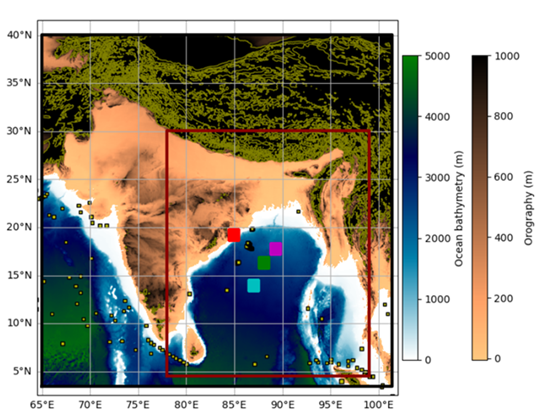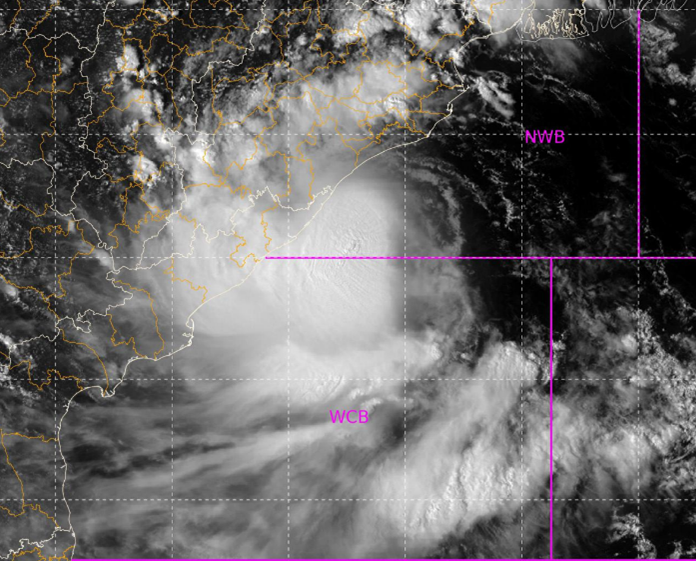Lead Supervisor: Kieran Hunt, University of Reading, Department of Meteorology
Email: k.m.r.hunt@reading.ac.uk
Co-supervisors: Andy Turner, University of Reading/NCAS, Ségolène Berthou, Met Office.
Monsoon depressions (MDs) are synoptic-scale features that are responsible for a significant fraction of the rain over northern India during the summer monsoon season. As such a strong contributor to the monsoon, the water they supply is vital to society, yet at the same time they can cause flooding which damages crops and infrastructure. MDs generally form in the Bay of Bengal before tracking westward across the coast and northern Indo-Gangetic plains, undergoing important interactions with the Himalayas. Their dynamical structure is complex, with some similarities to the more well-known tropical cyclones. However, they lack strong winds and an eye and unlike tropical cyclones have a cold core near the surface (Hunt et al., 2016). Monsoon depressions are sensitive to surface interactions, and features of their temperature, humidity and wind evolve during the coastal transition from ocean to land. Hunt et al. (2017) showed that increasing soil moisture on the land surface beneath the monsoon trough, a low-pressure region at the foot of the Himalayas, resulted in a greater likelihood of passing further into India, and a more developed structure with more precipitation, indicating that MDs are sensitive to heat and moisture exchanges at the surface. However, the role played by sea-surface conditions in the Bay of Bengal region, where MDs are generated, is still unclear.


Figure 1:topography of the Indian subcontinent and bathymetry of its surrounding seas.
Figure 2: high-resolution satellite image of a monsoon depression making landfall over east India (at the location of the red square in the left image).
It is well-known that air-sea interactions, the way in which the atmosphere and ocean mutually feedback on each other, play an important role in the development of tropical storms like MDs. Surface winds pick up moisture which fuel the storms, but they also cool the ocean surface making it less hospitable for further growth. However, in MDs, unlike tropical cyclones, these interactions are complicated by stronger SST gradients, the pre-existing monsoon circulation, nearby mountains, and the fact that MDs have weak surface winds. Therefore, the influence of SST and air-sea interactions on the structure, evolution and propagation of monsoon depressions remains unknown. Explaining these factors will help lead to improved understanding of the physics and dynamics of monsoon depressions and pave the way for improved forecasts of these important storms.
The UK Met Office, working with the National Oceanography Centre, have recently developed a regional “coupled” modelling framework for the Indian region, allowing the detailed study of atmosphere-wave-ocean interactions at the kilometre-scale (Castillo et al. 2022). At this resolution, it is also possible to resolve convection, giving a more faithful representation of some of the processes involved. This system will be a useful tool for improving weather forecasting over India, but more work is needed to understand the impact of coupling in a variety of weather situations. The work in this PhD will pursue a deep investigation of the role of air-sea interactions in Indian monsoon depressions.
The student will choose several monsoon depression cases and run multiple simulations with various flavours of coupling, including 1D (thermodynamic) or 3D (fully dynamic) oceans, and different SST datasets to address the following questions:
- How do SST patterns control monsoon depression genesis and propagation?
- How do coupled air-sea interactions affect the lifecycle of a monsoon depression?
- Can forecast models successfully represent monsoon depressions and which coupled processes are most important?
Training opportunities:
Through this project the student will develop strong programming skills and the ability to process and visualise large datasets, supported by bespoke training courses provided by NCAS. The project will offer placements at the Met Office, Exeter (e.g., one month per year) to develop hands-on experience working with the MetUM and NEMO models, learning from its developers, and improving skills in model workflows and data processing. The project will give the student the chance to discuss and present their work to a wider audience and presents the opportunity to engage with a leading employer of PhD graduates. The student will have the opportunity to undertake further training offered by NCAS in their Introduction to Atmospheric Science course and Climate Modelling Summer School. The student will have all the usual opportunities associated with a SCENARIO PhD such as developing presentation skills, networking at national and international conferences etc.
Student profile:
This project would suit a student with a background in physical or mathematical sciences, perhaps specialising in atmospheric physics or similar. The student must have strong analytical skills. During the project, the student will be expected to develop the necessary computer programming and climate data analysis skills. Some previous programming experience (in any language) would be beneficial.
Funding particulars:
This project has co-funding from the Met Office as a CASE studentship, comprising an additional £1,000 per annum towards the research and training grant for the student, and extra expenses for travel and subsistence associated with placements at the Met Office. In-kind support is also offered for model support at the Met Office.
References:
Castillo, J. M., Lewis, H. W., Mishra, A., Mitra, A., Polton, J., Brereton, A., et al. (2022). The Regional Coupled Suite (RCS-IND1): application of a flexible regional coupled modelling framework to the Indian region at kilometre scale. Geoscientific Model Development, 15(10), 4193–4223.
Hunt, K. M. R., Turner, A. G., Inness, P. M., Parker, D. E., & Levine, R. C. (2016). On the Structure and Dynamics of Indian Monsoon Depressions. Monthly Weather Review, 144(9), 3391–3416.
Hunt, K. M. R., & Turner, A. G. (2017). The Effect of Soil Moisture Perturbations on Indian Monsoon Depressions in a Numerical Weather Prediction Model. Journal of Climate, 30(21), 8811–8823.

